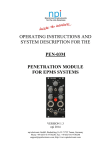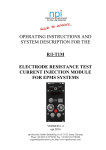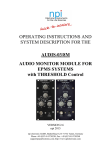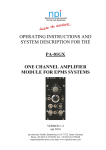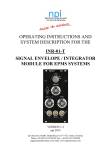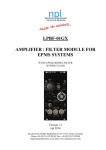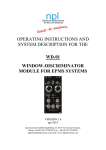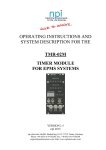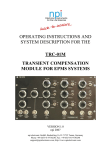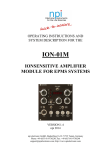Download OPERATING INSTRUCTIONS AND SYSTEM DESCRIPTION FOR
Transcript
OPERATING INSTRUCTIONS AND SYSTEM DESCRIPTION FOR THE DI-01NX INTEGRATOR AND DIFFERENTIATOR MODULE FOR EPMS SYSTEMS VERSION 1.3 npi 2014 npi electronic GmbH, Bauhofring 16, D-71732 Tamm, Germany Phone +49 (0)7141-9730230; Fax: +49 (0)7141-9730240 [email protected]; http://www.npielectronic.com DI-01NX User Manual ___________________________________________________________________________ Table of Contents 1. Safety Regulations .............................................................................................................. 3 2. EPMS-07 Modular Plug-In System .................................................................................... 4 2.1. General System Description / Operation ..................................................................... 4 2.2. EPMS-07 Housing ....................................................................................................... 4 2.3. EPMS-E-07 Housing ................................................................................................... 4 2.4. PWR-03D .................................................................................................................... 4 2.5. System Grounding ....................................................................................................... 5 EPMS-07 ..................................................................................................................... 5 EPMS-E-07.................................................................................................................. 5 2.6. Technical Data ............................................................................................................. 5 EPMS-07 ..................................................................................................................... 5 EPMS-E-07.................................................................................................................. 5 3. DI-01NX Differentiator / Integrator Module ...................................................................... 6 3.1. DI-01NX Components ................................................................................................. 6 3.2. DI-01NX System Description ..................................................................................... 6 3.4. Description of the Front Panel and Operation ............................................................. 7 4. Technical Data .................................................................................................................... 9 4.1. Electrical Data ............................................................................................................. 9 4.2. Functional Data ........................................................................................................... 10 ___________________________________________________________________________ version 1.3 page 2 DI-01NX User Manual ___________________________________________________________________________ 1. Safety Regulations VERY IMPORTANT: Instruments and components supplied by npi electronic are NOT intended for clinical use or medical purposes (e.g. for diagnosis or treatment of humans), or for any other life-supporting system. npi electronic disclaims any warranties for such purpose. Equipment supplied by npi electronic must be operated only by selected, trained and adequately instructed personnel. For details please consult the GENERAL TERMS OF DELIVERY AND CONDITIONS OF BUSINESS of npi electronic, D-71732 Tamm, Germany. 1) GENERAL: This system is designed for use in scientific laboratories and must be operated by trained staff only. General safety regulations for operating electrical devices should be followed. 2) AC MAINS CONNECTION: While working with the npi systems, always adhere to the appropriate safety measures for handling electronic devices. Before using any device please read manuals and instructions carefully. The device is to be operated only at 115/230 Volt 60/50 Hz AC. Please check for appropriate line voltage before connecting any system to mains. Always use a three-wire line cord and a mains power-plug with a protection contact connected to ground (protective earth). Before opening the cabinet, unplug the instrument. Unplug the instrument when replacing the fuse or changing line voltage. Replace fuse only with an appropriate specified type. 3) STATIC ELECTRICITY: Electronic equipment is sensitive to static discharges. Some devices such as sensor inputs are equipped with very sensitive FET amplifiers, which can be damaged by electrostatic charge and must therefore be handled with care. Electrostatic discharge can be avoided by touching a grounded metal surface when changing or adjusting sensors. Always turn power off when adding or removing modules, connecting or disconnecting sensors, headstages or other components from the instrument or 19” cabinet. 4) TEMPERATURE DRIFT / WARM-UP TIME: All analog electronic systems are sensitive to temperature changes. Therefore, all electronic instruments containing analog circuits should be used only in a warmed-up condition (i.e. after internal temperature has reached steady-state values). In most cases a warm-up period of 20-30 minutes is sufficient. 5) HANDLING: Please protect the device from moisture, heat, radiation and corrosive chemicals. ___________________________________________________________________________ version 1.3 page 3 DI-01NX User Manual ___________________________________________________________________________ 2. EPMS-07 Modular Plug-In System 2.1. General System Description / Operation The npi EPMS-07 is a modular system for processing of bioelectrical signals in electrophysiology. The system is housed in a 19” rackmount cabinet (3U) has room for up to 7 plug-in units. The plug-in units are connected to power by a bus at the rear panel. The plug-in units must be kept in position by four screws (M 2,5 x 10). The screws are important not only for mechanical stability but also for proper electrical connection to the system housing. Free area must be protected with covers. 2.2. EPMS-07 Housing The following items are shipped with the EPMS-07 housing: EPMS-07 cabinet with built-in power supply Mains cord Fuse 2 A / 1 A, slow Front covers In order to avoid induction of electromagnetic noise the power supply unit, the power switch and the fuse are located at the rear of the housing. 2.3. EPMS-E-07 Housing The following items are shipped with the EPMS-E-07 housing: EPMS-E-07 cabinet External Power supply PWR-03D Power cord (PWR-03D to EPMS-E-07) Mains chord Fuse 1.6 A / 0.8 A, slow Front covers The EPMS-E-07 housing is designed for low-noise operation, especially for extracellular and multi channel amplifiers with plugged in filters. It operates with an external power supply to minimize distortions of the signals caused by the power supply. 2.4. PWR-03D The external power supply PWR-03D is capable of driving up to 3 EPMS-E housings. Each housing is connected by a 6-pole cable from the one of the three connectors on the front panel of the PWR-03D to the rear panel of the respective EPMS-E housing. (see Figure 1, Figure 3). A POWER LED indicates that the PWR-03D is powered on (see Figure 1). Power switch, voltage selector and fuse are located at the rear panel (see Figure 2). Note: Although the chassis of the PWR-03D is connected to protective earth, it doesn’t provide protective earth to the EPMS-E housing. ___________________________________________________________________________ version 1.3 page 4 DI-01NX User Manual ___________________________________________________________________________ Figure 1: PWR-03D front panel view Figure 2: PWR-03D rear panel view Note: This power supply is intended to be used with npi EPMS-E systems only. 2.5. System Grounding EPMS-07 The 19" cabinet is grounded by the power cable through the ground pin of the mains connector (= protective earth). In order to avoid ground loops the internal ground is isolated from the protective earth. The internal ground is used on the BNC connectors or GROUND plugs of the modules that are inserted into the EPMS-07 housing. The internal ground and mains ground (= protective earth) can be connected by a wire using the ground plugs on the rear panel of the instrument. It is not possible to predict whether measurements will be less or more noisy with the internal ground and mains ground connected. We recommend that you try both arrangements to determine the best configuration. EPMS-E-07 The 19" cabinet is connected to the CHASSIS connector at the rear panel. It can be connected to the SYSTEM GROUND (GND) on the rear panel of the instrument (see Figure 3). Without this connection, the EPMS chassis and the chassis of all modules plugged in is free floating. Note: The EPMS-E-07 chassis is not connected to protective earth. Important:: Always adhere to the appropriate safety measures. Figure 3: Rear panel connectors of the EPMS-E-07 2.6. Technical Data 19” rackmount cabinet, for up to 7 plug-in units Dimensions: 133,4 mm (3U) high (1U=1 3/4” = 44.45 mm), 302 mm deep EPMS-07 Power supply: 115/230 Volts AC, 60/50 Hz, fuse 2/1 A slow, 45-60 W EPMS-E-07 External power supply (for EPMS-E): slow Dimensions of External power supply: 115/230 Volts AC, 60/50 Hz, fuse 1.6/0.8 A, (W x D x H) 225 mm x 210 mm x 85 mm ___________________________________________________________________________ version 1.3 page 5 DI-01NX User Manual ___________________________________________________________________________ 3. DI-01NX Differentiator / Integrator Module 3.1. DI-01NX Components The following items are shipped with the DI-01NX system: Differentiator / Integrator module for the EPMS-07 system User manual 3.2. DI-01NX System Description The DI-01NX unit was designed for differentiating or integrating time dependent signals. A low pass two-pole Bessel filter is implemented in order to allow distortion-free differentiation of very slow signals. Four time constants are available, which apply to both, the Differentiator and the Integrator. The selected time constant can be fine-tuned between 1% and 100%. with a potentiometer. In differentiator mode, a variable damp factor can be activated in order to avoid instability. DC offsets can be eliminated using the corresponding trim pots. Additionally, a reset switch and a reset input (TTL) are implemented for resetting the DI-01NX if necessary. Figure 4: Examples of input and output traces in Differentiator and Integrator mode ___________________________________________________________________________ version 1.3 page 6 DI-01NX User Manual ___________________________________________________________________________ 3.4. Description of the Front Panel and Operation Figure 5: DI-01NX front panel view ___________________________________________________________________________ version 1.3 page 7 DI-01NX User Manual ___________________________________________________________________________ In the following description of the front panel elements each element has a number that is related to that in Figure 5. The number is followed by the name (in uppercase letters) written on the front panel and the type of the element (in lowercase letters). Then, a short description of the element is given. (1) MODE OF OPERATION switch Switch for setting the operation mode of the DI-01NX (differentiator or integrator) (2) INTEGRATOR OFFSET trim pot Trim pot for correction of DC OFFSETs in integrator mode Time constant unit The time constant unit consist of (3) Time constant potentiometer and (4) Time constant switch (3) TIME CONSTANT potentiometer Potentiometer for selecting the time constant in % of the range set by switch #4 (4) TIME CONSTANT switch Switch for selecting a time constant range for the input signal Note: The time constant has to be selected according to the input signal. Otherwise the output signal might go into saturation. If this should happen, re-adjust the time constant and reset the DI-01NX module using the RESET unit (6, 9). (5) OUTPUT connector BNC connector providing the processed signal RESET unit The RESET unit consists of (6) TTL connector and (9) RESET push button (6) TTL connector If required, the DI-01NX can be reset by a TTL signal connected to this input (9) RESET push button If required, the DI-01NX can be reset manually pressing this button RESET is to be activated, when the output is in saturation (see 2). It can also be used to set a defined starting point in integration mode. ___________________________________________________________________________ version 1.3 page 8 DI-01NX User Manual ___________________________________________________________________________ (7) INPUT connector BNC connector for the input of the signal to be processed (8) FILTER switch Switch for filtering very slow signals in differentiator mode. The corner frequency of the two-pole Bessel filter is 10 Hz (10) K-FACTOR DIFFERENTIATOR potentiometer Potentiometer for damping the differential function in the case of instability (see also chapter 4). Not functional in Integration mode. (11) DIFFERENTIATOR OFFSET trim pot Trim pot for correction of DC OFFSETs in differentiator mode 4. Technical Data 4.1. Electrical Data Input impedance: Output impedance: Reset INPUT: INPUT voltage range: Output voltage range: FILTER: 10 Hz OFFSET: Time constants: Damp coefficient (diff. mode): 1 M 50 10 k / TTL (active high, +5V) ±10 V (integrator mode) d/dt (Uin)max=10 V/µs (differentiator mode) ± 10 V low pass Bessel, 2 pole (-12 dB/octave), corner frequency: trim pots, range: ±1 V Range: 1 ms, 10 ms, 100 ms, 1 s (set by rotary switch) 1% … 100% of range (set by potentiometer) K=100...10000 ___________________________________________________________________________ version 1.3 page 9 DI-01NX User Manual ___________________________________________________________________________ 4.2. Functional Data Differentiator mode: Frequency response: dU U out T in dt K 1 pT F ( p) K 1 pT0 K 10000 with T0 T ; K 100...10000 ; K With T as the time constant set at the front panel, i.e. the longer the time constant is set, the larger the output signal gets. Damping: High K-values mean low damping: lim F ( p ) pT K Low K-values mean high damping: lim F ( p ) 0 K 1 Integrator mode: 1 U in T 1 F ( p) pT U out Frequency response: With T as the time constant set at the front panel, i.e. the longer the time constant is set, the smaller the output signal gets. Damping: Damping does not apply in Integrator mode. ___________________________________________________________________________ version 1.3 page 10










